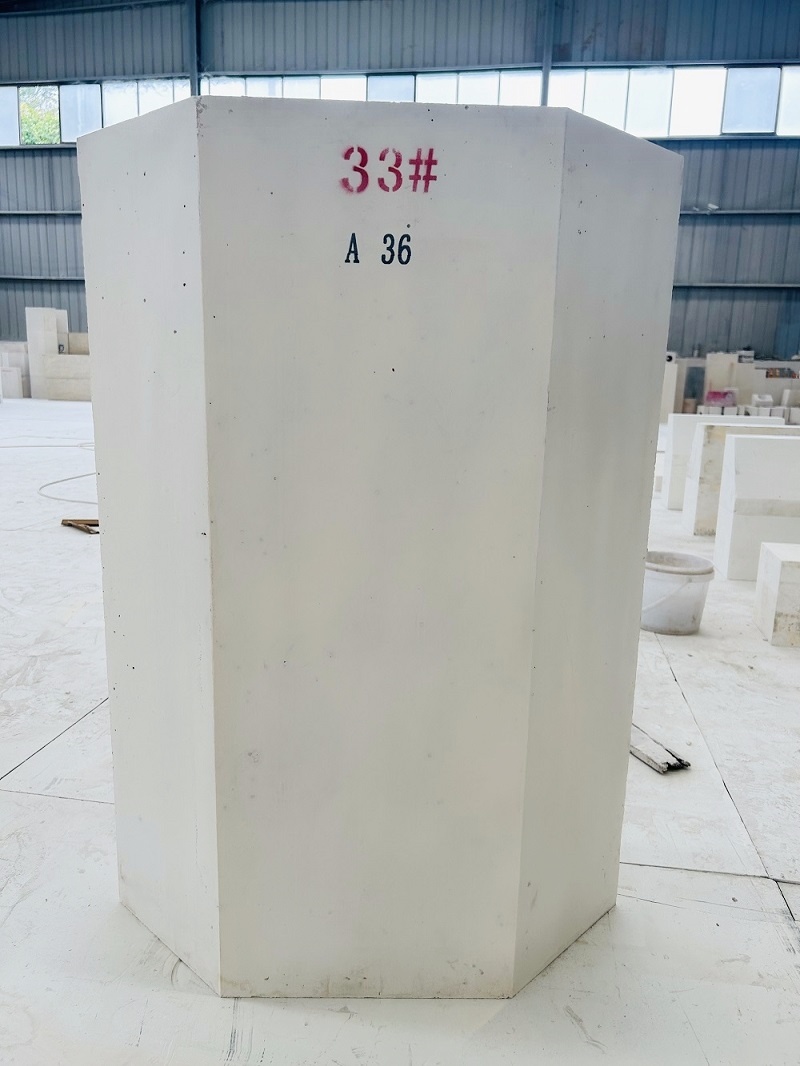Fused brick AZS33-Y
Classification:
Product Introduction
Fused brick AZS33-Y is a high-grade refractory material. "AZS" is an abbreviation for "Alumina - Zirconia - Silica" (Alumina - Zirconia - Silicon Dioxide). The "33" usually represents a zirconia (ZrO₂) content of about 33%. This type of brick is mainly composed of corundum (α - Al₂O₃), oblique zircon (ZrO₂) and glass phase (SiO₂). The corundum phase provides high hardness and good wear resistance, the zirconia phase improves the thermal shock resistance of the material, and the glass phase helps bond other phases together at high temperatures.
1. Performance characteristics
High temperature resistance: It can withstand extremely high temperatures, and can generally be used for a long time in a high temperature environment above 1700°C. This makes it excellent in high-temperature industrial equipment such as glass furnaces, for example, in the glass melting process, it can resist the erosion of molten glass and the action of high temperatures, ensuring the normal operation of the furnace.
Erosion resistance: It has good erosion resistance to molten glass and slag. In glass manufacturing, molten glass contains a variety of chemical components, such as alkali metal oxides, etc., and fused brick AZS33-Y can effectively prevent the erosion of these components on the brick body and prolong the service life.
Chemical stability: It can maintain chemical stability in high temperature and complex chemical environment. It does not react violently with most acidic or alkaline substances, ensuring safety and stability during use.
Density and strength: It has high density and mechanical strength. The high density helps to reduce the porosity of the brick, thereby further improving its erosion resistance and high temperature resistance; Good mechanical strength makes it able to withstand the weight of the equipment and other external forces, and is not easy to damage.
2. Production process
It is produced by electrofusion. After mixing the raw materials in a certain proportion, they are put into an electric furnace and melted at a high temperature (generally more than 2000 °C). The melted liquid cools and solidifies in the mold to form bricks. Then after cutting, grinding and other processing processes, it is made into fused bricks that meet the size requirements. In the electrofusion process, it is very important to accurately control parameters such as temperature and current, which will affect the crystallization and performance of the brick.
3. Application field
Glass industry: It is a key refractory material for glass furnaces. In the float glass production line, it is used for the wall and bottom of the furnace. For example, in furnaces that produce various glass products such as automotive glass, architectural glass, etc., fused brick AZS33-Y can ensure the smooth progress of the glass melting process and improve the quality of glass.
Ceramic industry: It is also used in some high-temperature ceramic firing kilns. For example, in the kiln where high-grade sanitary ceramics and electronic ceramics are fired, it is used as a lining material to help maintain the high temperature environment in the kiln and resist the chemical attack that may occur during the firing process of the ceramic body.
Metallurgical industry: in the smelting furnace of some non-ferrous metals (such as aluminum, copper, etc.), it is used as a refractory lining to protect the furnace body, reduce the reaction between the molten metal and the furnace wall, and improve the service life of the furnace.
| Projects | Physical and chemical indicators | ||||
| AZS33-Y | AZS36-Y | AZS41-Y | |||
| Chemical Composition % | Al2O3 | / | (Margin) | ||
| ZrO2 | / | 32~36 | 35~40 | 40~44 | |
| SiO2 | ≤ | 16 | 14 | 13 | |
| Na2O | ≤ | 1.45 | 1.45 | 1.30 | |
| (Fe2O3+TiO2+CaO+MgO+Na2O+K2O) | ≤ | 2 | 2 | 2 | |
| (Fe2O3+TiO2) | ≤ | 0.3 | 0.3 | 0.3 | |
| Bulk density (g/cm3) | ≥ | 3.75 | 3.80 | 3.95 | |
| Apparent porosity/% | ≤ | 1.5 | 1.0 | 1.0 | |
| Resistance to the erosion rate of molten glass at rest (Ordinary soda-lime glass, 1500°C×36h)/(mm/24h) | ≤ | 1.60 | 1.50 | 1.30 | |
| Initial precipitation temperature of glass phase/°C | ≥ | 1400 | 1400 | 1400 | |
| Bubble precipitation rate (ordinary soda-lime glass, 1300°C×10h)/% | ≤ | 2.0 | 1.5 | 1.0 | |
| Glass phase exudation (1500°C×4h)% | ≤ | 2.0 | 3.0 | 3.0 | |
| Thermal expansion rate (room temperature ~1000°C)/% | ≤ | Provide measured data | |||
| Bulk density(Kg/m3) | PT、QX | > | 3400 | 3450 | 3550 |
| ZWS | > | 3600 | 3700 | 3850 | |
| WS | > | 3700 | 3750 | 3900 | |
Key words:
Fused brick AZS33 - Y
Fused brick
Related Products
Product inquiry


